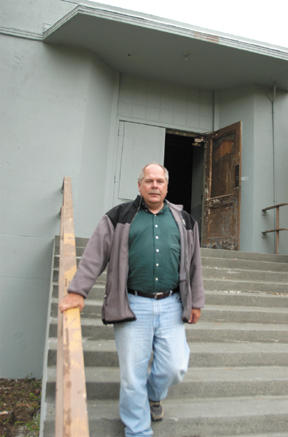Most of the junk has been hauled off.
Only the basement remains strewn with paint cans, building materials, a sailboat of dubious buoyancy, and whatever else has accumulated over a period of decades.
“This tire – who knows how long ago it was put here?” Terry Lande says, kicking through the still-formidable mess. “There were hundreds of things like that in here. There was stuff in here from the ‘70s and ‘80s that nobody had used since then.”
A repository for detritus and debris – that’s been the sorry plight of the historic transmitter building at Battle Point Park.
But in Lande, who took over last month as Bainbridge Island Park and Recreation District director, the structure has a new champion, and perhaps a happier future.
He sees the building – with needed upgrades – becoming a new home for youth gymnastics and other programs.
Constructed in 1941 by the U.S. Navy as part of Battle Point Transmitting Station NPC – “the Navy’s voice to the North Pacific fleet,” as it was described by the late Ivan Lee, author of a book on local military sites – the building sits behind the caretaker’s residence inside the park’s east gate.
Its upper floor boasts more than 3,300 square feet of open floor space and a not-quite-12-foot ceiling; its basement, which you can literally drive a truck into via an outside ramp, includes a large open area and a warren of smaller rooms.
For want of funds or interest, it has sat in abject disrepair for years. The basement routinely floods, and vandals have taken their own toll, breaking out most of the once-attractive block-glass windows.
“I had former vets come see me at the museum, in tears over the terrible condition it’s in,” Bainbridge historian Jerry Elfendahl said.
As part of an ongoing cleanup – which got under way several weeks ago, and sent several garbage totes of material to the landfill – the massive concrete structure got a fresh coat of battleship gray paint. Now Lande wants to see it get a new roof, some electrical work and a rudimentary heating system, and some type of flooring, to add it to the district’s roster of indoor spaces in active use.
“It’s a great facility,” he said. “When resources are short, you try to make do. We’re trying to make do.”
Earlier this year, park commissioners approved a plan to spend $26,000 on upgrades to a metal building at John Nelson Park off Highway 305, to turn it into a gymnastics facility.
But questions of access dog that project. The driveway is often fouled by highway traffic, a problem park officials believe will be exacerbated when a planned 39-unit development goes in next door.
So Lande has a new plan: reallocate the Nelson money, and shuffle uses between the two parks.
He wants to move the district’s maintenance department out to a corner of John Nelson Park – retaining, he stresses, most of that property for community use. That would free up the current maintenance center, a small wooden building at Battle Point’s east gate, for use as a volunteer center, pea-patch nursery and classroom space.
Put a refurbished transmitter building in the mix, and Lande sees a more inviting, park-like entrance to the 90-acre grounds.
Lande said he has already been asking around for bids on a new transmitter building roof – which he says is needed just to prevent further deterioration, regardless of the building’s long-term prospects – and believes funds can be found in the district’s current revenues.
A public hearing will be held at some point. The proposal appears on this week’s park board agenda, but only for discussion.
The Battle Point Transmitting Station was developed during World War II as a companion to the Navy radio school at Fort Ward. Messages from the Pacific fleet were received at the fort, with replies sent back via the 800-foot high antenna at Battle Point.
It marked the Navy’s first attempt to transmit radio messages to submarines under water.
So formidable was the antenna that the first time the system was fired up, the nails in the wooden helix building – where a large coil matched the power outputs of transmitter and antenna – glowed red-hot in the walls.
The helix structure was subsequently replaced with a concrete building at the south end of the grounds; volunteers have since turned it into an observatory.
Central to the Battle Point facility was the transmitter building, which housed equipment and administrative offices.
“Our main thing was to make sure the transmitters were working properly and that they were ‘on-frequency,’” said islander Vince Wolf, who as Navy radioman first class was stationed at Battle Point from 1946-48.
Elfendahl says the transmitter building – decommissioned with the base, which became a park in the late 1960s – has never been nominated for the National Register of Historic Places. Getting it on that register could make the building eligible for preservation grants. An identical structure sits in pristine condition on Indian Island in Jefferson County, he said.
Should the transmitter building be restored, Wolf said he wants to donate photographs of his fellow servicemen there – and a pen-and-ink drawing of Smokey, the base’s beloved German shepherd, who upon his demise was buried next to the fire plug in front of the building.
“I would like to have his picture in the power house,” Wolf said.



